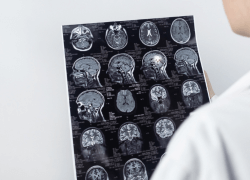7 Types of Car Accident Injuries

The car accident lawyers at Curtis Legal Group have seen countless accidents that result in life-altering car accident injuries. Below, we discuss 7 types of car accident injuries:
- Whiplash
- Traumatic Brain Injury
- Spinal Cord Damage
- Internal Bleeding
- Burns
- Amputations
- Broken Bones
- Legal Options after sustaining Car Accident Injuries
1. Car Accident Whiplash
Even an apparently minor rear-end car accident can cause whiplash. Whiplash is a neck injury occurring when the neck experiences rapid back-and-forth movement, similar to the movement of a cracking whip. Some cases of whiplash can resolve within a few weeks, but others can affect victims for months, years, or even permanently.
Symptoms common to whiplash include neck pain or stiffness and reduced range of neck motion, headaches, shoulder, upper back, or arm pain, numbness or tingling in the arm, fatigue, and dizziness.
2. TBI From a Car Accident

Concussions, often categorized as “minor” or “moderate” forms of TBI, can lead to memory problems and diminished ability to reason and learn. Victims may experience chronic headaches and fatigue as well.
More severe TBIs bring more extensive lapses in cognition and can disrupt or disable physical, mental, and emotional function. Since the brain controls all the body’s systems, a TBI can cause failure in these systems, affecting victims’ ability to speak, swallow, walk, show affection, and / or control their emotions.
3. Spinal Injury from a Car Accident
According to the United Spinal Association, 17,700 people sustain spinal cord injuries each year. Of this number, 39.3% are caused by motor vehicle accidents.
Spinal cord damage occurs when the tight bundle of cells and nerves that sends and receives signals from the brain to and from the rest of the body is traumatized. More moderate forms of these injuries are still debilitating, often causing chronic pain, numbness, or tingling sensations in certain parts of the body.
More severe spinal cord injuries lead to partial or total paralysis – paraplegia or quadriplegia, rendering victims unable to care for themselves independently. Sadly, these injuries instigate other medical conditions such as problems with a victim’s bowel, bladder, and respiratory functions, sexual dysfunction, and depression, among others.
4. Internal bleeding from Car Accident

When the brain or other organs bleed internally, victims can experience dangerous blood loss. If this blood loss goes unchecked, they can experience organ failure, coma, or even wrongful death.
5. Car Crash Burns

Both the first and second layers of skin are affected by second-degree burns, which cause swelling, turn skin red, white, or “splotchy,” and blisters. These burns typically leave scars and cause severe pain.
Some victims sustain third-degree burns, which reach into the layer of fat beneath the skin. These burns can turn affected skin black, brown, or white and create a leathery skin texture. Third-degree burns are especially devastating, destroying nerves, requiring painful skin grafts and rehabilitation, and leaving victims disfigured.
6. Car Accident Amputation
In an auto collision, vehicles can be damaged in such a way as to injure victims with the sharp or jagged edges of bent or crushed metal. Victims can sustain deep lacerations requiring stitches and plastic surgery, and careful treatment to avoid infection. Sometimes, the lacerations are so deep as to cause or require limb amputation.
7. Car Wrecks and Broken Bones
Broken bones are a common result of car accidents. Many broken bones can heal completely, although they may require surgery and / or rehabilitation. In some cases, however, bones cannot or do not heal properly, and victims have to adapt to limited function in the area affected.
Legal Options After Sustaining Car Accident Injuries
When your life is affected by a car accident injury, either temporarily or permanently, and someone else’s negligence causes that collision, you can pursue financial compensation for your losses. An experienced car accident lawyer from Curtis Legal Group will review your case and your injuries, evaluate your losses, and fight for a fair settlement or take your case to trial to obtain the best possible verdict.
